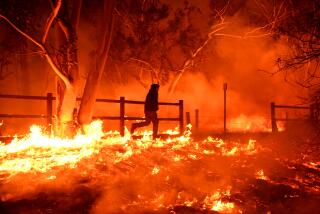Placing power lines underground is an expensive way to reduce fire danger

The worst fire in California history took off at a spot notorious for its intense winds.
The gusts — some topping 100 mph — blow down the Feather River Canyon each fall. They push into the town of Paradise with force, powered by high-pressure air parked over the Great Basin that moves through this narrow corridor of the Sierra Nevada.
In November, the winds blasted through the canyon with warm, dry air at sunrise. Power equipment owned by Pacific Gas & Electric Co. failed, sparking a fire that killed 85 people and destroyed most of the town of Paradise in a matter of hours.
This week, PG&E announced it would rebuild Paradise’s power system underground. The process is expensive and speaks to the huge challenges facing California utilities after a series of destructive fires, experts say.
Utilities have been blamed for starting more than 2,000 fires in the last few years, including the Camp fire in Paradise, the wine country infernos and the Thomas fire, which blackened 281,893 acres in Ventura and Santa Barbara counties in 2017.
“It didn’t used to be so dangerous,” said Michael Wara, director of Stanford University’s climate and energy policy program. “What’s become different in California is we have existing high fire risk — we’ve had it forever — we’ve been suppressing fire [for decades] pretty effectively, and we’ve built up all this valuable real estate and put people where the fires burned, and it’s all coming to a head.”
Liabilities from the fire that destroyed Paradise have already pushed PG&E into bankruptcy. And it along with California’s two other huge electricity suppliers — Southern California Edison and San Diego Gas & Electric Co. — are now scrambling to make safety improvements in an era of deadlier and more destructive wildfires.
The utilities have announced a series of steps, including strengthening existing power lines to better sustain winds and shutting off power to large areas when winds pick up.
Edison is installing cameras in isolated areas so it can monitor its grid in real time, and San Diego Gas & Electric is replacing miles of wooden power poles with metal ones that have wide cross arms to keep power lines from slapping each other in high winds.
Placing power lines underground is an appealing idea because it would significantly reduce wind-related dangers.
But it’s also one of the most expensive fixes.
Cost estimates vary wildly. But a 2013 report by the Edison Electrical Institute put the price tag per mile in the millions, with the costs in urban areas much higher than in rural areas. And some of those costs could be passed on to ratepayers.
In the wake of both the Camp fire and the Woolsey fire that burned through Ventura County and Malibu last fall, utilities have faced mounting pressure to move more lines below ground.
“It’s almost 18th century technology, in some ways,” then-Malibu Mayor Rick Mullen told state lawmakers last year about overhead lines. “Let’s make the investment to make the system durable.”
PG&E has not said how much it will cost to put Paradise power lines underground, adding that the process will take five years. Because of the level of destruction, the utility was going to have to rebuild the power system in Paradise regardless.
While the system in Paradise will be below ground, the massive transmission line that sparked the blaze — several ridges away from the town — would not be covered by the project. PG&E said there will be no cost to the town of Paradise, but a town councilman said some are skeptical.
“People are questioning the reasons they’re doing it now, which is natural,” said Paradise Councilman Michael Zuccolillo. “People are still emotionally charged after six months.”
Given the high costs of underground projects, California utilities have turned to less expensive solutions.
PG&E warned San Francisco and other Bay Area cities that potentially millions of residents could lose power if the utility turns off part of the power grid as a fire safety measure. Edison’s and San Diego’s fire mitigation strategies also include power shut-offs, which can drastically reduce the odds a fire will break out.
But it’s typically a last-resort option, and power shut-offs can leave residents who do not live in fire-prone zones without electricity. The strategy also requires close monitoring of humidity and dryness, and the utilities don’t always make the right call.
PG&E canceled a planned power shut-off in the Paradise area just before the Camp fire broke out in November, and Edison is being sued by victims of the Woolsey fire who say the utility company should have de-energized power lines on the dry, windy day the deadly fire started.
The issue with that strategy, experts say, is that once the lines are shut down, every inch of them has to be inspected before they can be re-powered in case they have fallen or are in contact with a tree.
San Diego Gas & Electric introduced the idea of proactively shutting off power after the Witch fire in 2007, and it was initially met with resistance from state regulators, Wara said. But since then, he said, the utility has refined the technique and created “micro-grids” within its system so that a shutdown may affect only 10,000 customers, not 100,000.
Experts have said that despite the heavy costs, burying power lines in areas most susceptible to winds would provide a huge margin of safety.
San Diego has been ahead of the curve, placing thousands of miles of power lines underground over the last few decades. Part of the motivation has been aesthetic, clearing ocean views for residents. But it has also helped reduce fire risk.
In 2016, San Diego Gas & Electric began an ambitious plan to make power lines in the Cleveland National Forest more resistant to fire. That included burying 30 miles of lines underground in sensitive areas.
In Paradise, PG&E’s announcement that it would bury power lines was welcomed, but some questioned the utility’s motivation. Zuccolillo said he believes PG&E, in part, is seeking to improve its public image as it faces lawsuits from residents who lost homes.
“I think people are happy about it, but some people feel like it’s too little too late,” he said.
Mark Toney, executive director for the Utility Reform Network, praised PG&E’s plans for Paradise but pointed out that putting utilities underground is too costly and takes too long to do on a mass scale. He said PG&E didn’t do enough before Paradise and other major fires to improve safety.
“I guess we’re concerned that for too many years PG&E has been run by investment managers for whom the bottom line was the primary metric,” Toney said.
Zuccolillo hopes PG&E’s effort will work. “At the end of the day, we’re going to have a safer town,” he said.
“I hope this is a wake-up [call] to them and other utilities proving that we need to value infrastructure. I just hope this will result in a cultural change for them.”
More to Read
Start your day right
Sign up for Essential California for news, features and recommendations from the L.A. Times and beyond in your inbox six days a week.
You may occasionally receive promotional content from the Los Angeles Times.








